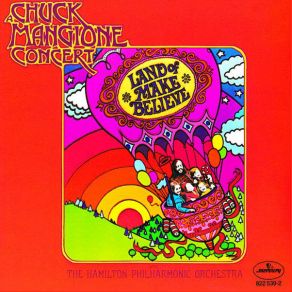Land of Make Believe
Download links and information about Land of Make Believe by Chuck Mangione. This album was released in 1973 and it belongs to Jazz, Contemporary Jazz, Crossover Jazz, Smooth Jazz genres. It contains 6 tracks with total duration of 39:15 minutes.

|
|
|---|---|
| Artist: | Chuck Mangione |
| Release date: | 1973 |
| Genre: | Jazz, Contemporary Jazz, Crossover Jazz, Smooth Jazz |
| Tracks: | 6 |
| Duration: | 39:15 |
| Buy it NOW at: | |
| Buy on iTunes $5.99 | |
| Buy on Amazon $7.99 | |
| Buy on Amazon $24.25 | |
Tracks
[Edit]| No. | Title | Length |
|---|---|---|
| 1. | Legend of the One-Eyed Sailor (featuring Hamilton Philharmonic Orchestra) | 7:41 |
| 2. | Lullaby for Nancy Carol (featuring Hamilton Philharmonic Orchestra) | 3:39 |
| 3. | El Gato Triste (featuring Hamilton Philharmonic Orchestra) | 7:26 |
| 4. | Gloria from the Mass of St. Bernard (featuring Hamilton Philharmonic Orchestra) | 4:10 |
| 5. | As Long As We're Together (featuring Hamilton Philharmonic Orchestra) | 3:55 |
| 6. | Land of Make Believe (featuring Esther Satterfield, Hamilton Philharmonic Orchestra) | 12:24 |
Details
[Edit]Though much less expansive than Mangione's other Mercury concerts (only 37 minutes on a single CD or LP), Land of Make Believe is the most successful of the lot, a winning combination of attractive tunes, big-thinking orchestrations, just enough jazz content, and a genuinely felt sense of idealism. Here there is no dead weight; all of the material is very engaging and the combined forces of Mangione's quartet and the Hamilton (Ontario) Philharmonic are on fire. The performance of Mangione's "Legend of the One-Eyed Sailor" still exerts a ferocious jolt of life-affirming energy, "El Gato Triste" is an attractive Latin number, and the buoyant "Gloria" from The Mass of St. Bernard with the Horsehead Chamber Singers makes one want to hear more. The childlike title tune has both a touching sense of naïveté and a lot of drive in key spots — credit expert drummer Joe LaBarbera with the latter — and Esther Satterfield's clear-eyed Nancy Wilson-like vocals made her famous for a time. This would be Mangione's most irresistible attempt at embracing the whole world of music — and for awhile, it was possible to believe that he would become a major unifying figure in American music. Alas, thus far this would be the last full flowering of that promise. ~ Richard S. Ginell, Rovi